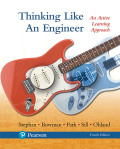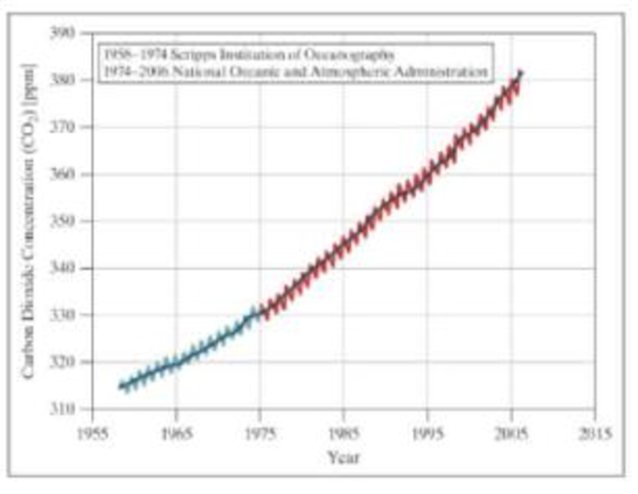
One of the NAE Grand Challenges for Engineering is Develop Carbon Sequestration Methods Accord1ng to the NAE website “In pre-industrial times, every million molecules of air contained about 280 molocules of carbon dioxide. Today that proportion exceeds 380 molecules per million, and 11 continues to climb. Evidence is mounting that carbon dioxide’s heat-trapping power has already started to boost average global temperatures. If carbon dioxide levels continue upward, further warming could have dire consequences, resulting from rising sea levels, agriculture disruptions and stronger storms (e.g, hurricanes) striking more often·”
The Mauna Loa Carbon Dioxide Record is the longest continuous record of atmospheric concentrations of carbon dioxide (CO2), the chief greenhouse gas responsible for global climate warming. These data are modeled as the Keeling curve, a graph showing the variation in concentration of atmospheric CO2 based on measurements taken at the Mauna Loa Observatory in Hawali under the supervision of Charles David Keeling. It is often called the most important geophysical record on Earth and has been instrumental in showing that mankind is changing the composition of the atmosphere through the combustion of fossil fuels.
The Keeling curve also shows a cyclic variation in each year corresponding to the seasonal change in the uptake of CO2 by the world’s land vegetation. Most of this vegetation is in the northern hemisphere, where most of the land is located. The level decreases from northern spring onward as new plant growth takes CO2 out of the atmosphere through photosynthesis and rises again in the northern fall as plants and leaves die off and decay to release the gas back into the atmosphere.
Data and wording for this problem set were obtained from www.esrl.noaa.gov/gmd/ccgg/trends/. Additional information on the Mauna Loa Observatory can be found at http://scrippsco2.ucsd.edu/
Note
In the graph, A and Bare not drawn to scale, and the locations of C, D, and E are approximate In other words, you cannot guess the value based upon the graph—you must calculate the value.

Examine the estimated increase in monthly CO2 emissions for 2019, taken from the Mauna Loa data set. All values given are in parts per million [ppm] CO2 as the difference between the December 2018 and the monthly 2019 reading.

a. What is the mean of these data?
b. What is the median of these data?
c. The variance of the data set shown here is 5.37 parts per million squared [ppm2]. What is the standard deviation of these data?
d. The estimated annual growth rates for Mauna Loa are close, but not identical to the global growth rates. The standard deviation of the differences is 0.76 parts per millon per year [ppm/year]. What is the variance?
Want to see the full answer?
Check out a sample textbook solution
Chapter 14 Solutions
EBK THINKING LIKE AN ENGINEER
- Show all work pleasearrow_forwardDraw top, side, front view With pen(cil) and paper Multi view drawing and handwriting all of itarrow_forwardA wheel of diameter 150.0 mm and width 37.00 mm carrying a load 2.200 kN rolls on a flat rail. Take the wheel material as steel and the rail material as cast iron. Assume the figure given, which is based on a Poisson's ratio of 0.3, is applicable to estimate the depth at which the maximum shear stress occurs for these materials. At this critical depth, calculate the Hertzian stresses σr, σy, σz, and Tmax for the wheel. 1.0 0.8 0, т Ratio of stress to Pmax 0.4 0.6 90 69 0.2 0.5b b 1.5b Tmax 2b Distance from contact surface The Hertizian stresses are as follows: 02 = or = -23.8 psi for the wheel =| necessary.) σy for the wheel =| MPa σz for the wheel = MPa V4 for the wheel = | MPa 2.5b ཡི 3b MPa (Include a minus sign ifarrow_forward
- 4. Solve for the support reactions at A and B. W1 600 lb/ft W2 150 lb/ft A Barrow_forwardIn cold isostatic pressing, the mold is most typically made of which one of the following: thermosetting polymer tool steel sheet metal textile rubberarrow_forwardThe coefficient of friction between the part and the tool in cold working tends to be: lower higher no different relative to its value in hot workingarrow_forward
- The force F={25i−45j+15k}F={25i−45j+15k} lblb acts at the end A of the pipe assembly shown in (Figure 1). Determine the magnitude of the component F1 which acts along the member AB. Determine the magnitude of the component F2 which acts perpendicular to the AB.arrow_forwardHi can you please help me with the attached question?arrow_forwardHi can you please help me with the attached question?arrow_forward
 Elements Of ElectromagneticsMechanical EngineeringISBN:9780190698614Author:Sadiku, Matthew N. O.Publisher:Oxford University Press
Elements Of ElectromagneticsMechanical EngineeringISBN:9780190698614Author:Sadiku, Matthew N. O.Publisher:Oxford University Press Mechanics of Materials (10th Edition)Mechanical EngineeringISBN:9780134319650Author:Russell C. HibbelerPublisher:PEARSON
Mechanics of Materials (10th Edition)Mechanical EngineeringISBN:9780134319650Author:Russell C. HibbelerPublisher:PEARSON Thermodynamics: An Engineering ApproachMechanical EngineeringISBN:9781259822674Author:Yunus A. Cengel Dr., Michael A. BolesPublisher:McGraw-Hill Education
Thermodynamics: An Engineering ApproachMechanical EngineeringISBN:9781259822674Author:Yunus A. Cengel Dr., Michael A. BolesPublisher:McGraw-Hill Education Control Systems EngineeringMechanical EngineeringISBN:9781118170519Author:Norman S. NisePublisher:WILEY
Control Systems EngineeringMechanical EngineeringISBN:9781118170519Author:Norman S. NisePublisher:WILEY Mechanics of Materials (MindTap Course List)Mechanical EngineeringISBN:9781337093347Author:Barry J. Goodno, James M. GerePublisher:Cengage Learning
Mechanics of Materials (MindTap Course List)Mechanical EngineeringISBN:9781337093347Author:Barry J. Goodno, James M. GerePublisher:Cengage Learning Engineering Mechanics: StaticsMechanical EngineeringISBN:9781118807330Author:James L. Meriam, L. G. Kraige, J. N. BoltonPublisher:WILEY
Engineering Mechanics: StaticsMechanical EngineeringISBN:9781118807330Author:James L. Meriam, L. G. Kraige, J. N. BoltonPublisher:WILEY





